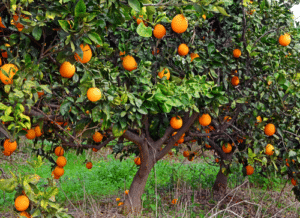
The last of the Smith family weather radios
A weather radio sat on my kitchen table. I woke up every day to Radio 700 AM broadcasting weather and news. Weather dominated our conversations. The memories and realities of whether it was going to “rain or shine” controlled the order of the farm day (other than the constant of milking cows).
The cutting of hay or planting of crops could be adjusted based on the forecast. But the unexpected — then and now — of scorching heat waves, tornados, floods, hurricanes and drought are weather events a farmer or rancher may be able to mitigate but never avoid.
“There is no bad weather, only bad clothing” may be true when it comes to our own preparation, but weathering the risk of growing food extends beyond personal control. From a farmer’s profitability to the recent news of higher orange juice prices, weather controls everyone’s bottom line … a risk that we all must share for the benefit of food on the table.
The Orange Juice Squeeze
With soaring egg prices1 dominating the recent headlines, higher cost of other mainstream items may not be on the radar screen. Orange juice, the product where most of the Florida oranges go, is increasing in price as the product availability is at its lowest level since the 1930s. Why?

In terms of numbers, the projected yield of 20 million boxes of Florida oranges this year compared to the 240 million in the early 2000s reflects the cruel reality.
With the dwindling U.S. supply, orange juice prices may increase 7% or so. However, national companies are using imported orange supplies — mainly from Brazil and Mexico — to offset higher prices. For consumers, we can limit our orange juice purchases. But for the farmer, the stakes are higher: the ability to stay in business or not.
The Economics of Weather

In fact, our U.S. farmers supply close to 25% of the global supply of the listed grain crops.4 Reduced crop yields of grains to citrus and almonds are drought realities. But so is the reduced ability to maintain livestock herds. With little to no water and grazing pastures, ranchers are forced to make economic choices that will affect their long-term livelihood. While these drought challenges ultimately are reflected in our grocery bill, it’s not life changing. We still have food.
A Ray of Hope
Extreme weather events are not all “doom and gloom.” While the three-week seize of heavy rain in California has created disaster, it has also reduced the effects of another. For the first time in three years, California is expected not to be under an extreme drought warning.5
Why does this matter? It’s good news for citrus and produce growers and the consumer. The rain and increasing snowpack in the California mountains are bringing a sigh of relief to the state’s agriculture economic situation as well the U.S. and global markets.

Rising prices of our favorite brands or food items are never welcomed. Neither is the lack of quality or availability of our favorite fruit in the produce section. When we don’t live in areas where extreme weather conditions are in play, the connection of weather and food may not extend beyond wearing a raincoat to the grocery store. But that’s not the reality! We rely on our farmers and ranchers to mitigate the risks to keep food on our tables … sometimes a risk we all have to share.
Notes
1. “Soaring U.S. egg prices put pressure on consumers, businesses,” by the Associated Press, republished by NBC News, January 12, 2023.
2. “OJ prices are rising: Florida orange production expected to fall to lowest level in over 80 years,” by Danielle Wiener-Bronner, CNN, December 16, 2022. Reposted by KCRA Channel 3 Sacramento.
3. “Record drought gripped much of the U.S. in 2022,” National Oceanic and Atmospheric Administration, January 10, 2023.
4. “Climate Impacts on Agriculture and Food Supply,” U.S. Environmental Protection Agency.
5. “Rain brings long-term gain but short-term harvest delays for California citrus,” by Tom Karst, The Packer by Farm Journal, Inc., January 19, 2023.
